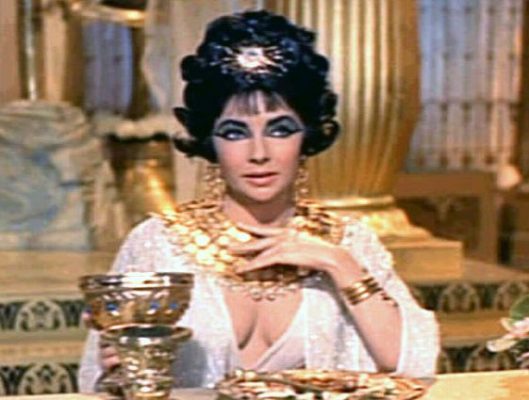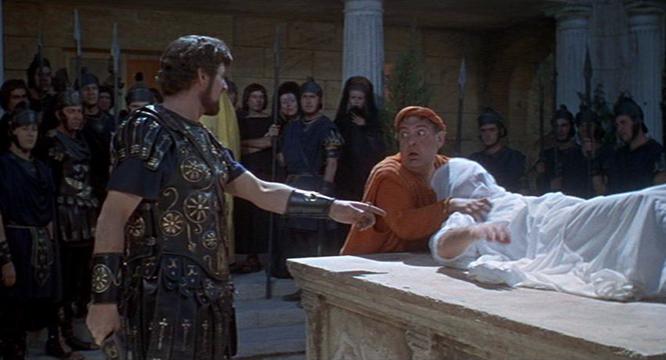The cinematic world has been able to use its tools in order to project ancient and contemporary stories in a way that connects with the audience, for “political, artistic, and ideological uses.”[1] Thus, while the audience gets to view the producer’s interpretation of the story, there are also subtle parallels in the film that mimic the values, concerns and important figures of the time. In particular, the historic figure of Cleopatra has been manipulated throughout the decades, both in film and in ancient texts. Roman poets such as Vergil illustrate Cleopatra as an evil ruler, with the Egyptian Gods on her side, while Octavian is described in otherworldly terms, “his happy brow shoot[ing] out twin flames,” vanquishing the evil of the East.[2] Propertius simply refuses to acknowledge her by name. However, Horace does acknowledge that her choice of death by suicide is admirable, “show[ing] no sign of womanish fear at the sword,” given that this is how Roman men would honorably die.[3] On the other hand, Plutarch’s Life of Antony recognizes that although Cleopatra might have been the downfall of Antony, she was an adept ruler who was loved by her people.
In Hollywood cinema, Cleopatra has transitioned from being compared to a “vamp” that sucks the life out of men portrayed by Theda Bara, to the childish depiction by De Mille’s Claudette Colbert, to the voluptuous portrayal by Elizabeth Taylor in Mankiewicz’s 1963 epic film.[4] Although the prior two depictions of Cleopatra are both excellent examples of how American culture influenced her character, this blog post will focus on the 1963 film.

Elizabeth Taylor in Mankiewicz’s 1963 film. From http://commons.wikimedia.org/wiki/File:Liz_Taylor_1963.jpg
The American culture of the 1960’s was influenced by a second wave of feminism, inspirational leadership, and extravagance. Mankiewicz envisioned a Cleopatra who would reflect these influences. For example, Golda Meir, a female politician in the Middle East was an example to the world that women could hold their own in politics.[5] John F. Kennedy’s election to the American presidency served as hope for change and global peace during the Cold War after the failure of the United Nations.[6] Compared to DeMille’s Cleopatra, the Cleopatra of 1963 is cunning, intelligent and a military leader. For example, Cleopatra orchestrates the battles against Octavian, whilst Antony lounges around in milk baths. Taylor’s depiction of Cleopatra is a woman who envisions a unified Roman world, and wants to become a part of that empire. In particular, the scene where she stands before Alexander’s tomb with Caesar alludes to JFK’s calls for peace and unification and the eloquent speeches of the time by Martin Luther King Jr. She begs Caesar to, “Make [Alexander’s] dream yours…out of the patchwork of conquest, one world, out of one world, one nation, one people on earth living in peace…”[7]
The sexy portrayal of Cleopatra also illustrates the question of the female role in 1960 American society. During this time women not only looked up to the elegant and poised first lady, Jaquelin Kennedy, but also witnessed the lavish lifestyle and male attention given to Marilyn Monroe, who is said to have had an affair with JFK. While the Cold War brought up concerns about Communism and the disintegration of morality, many academic publications, such as Alfred Kinsey’s Sexual Behavior in the Human Female questioned the role of female sexuality and monogamy, and women found sexual independence when oral contraceptives became available.[8]
Mankiewicz’s film offered a spectacle that brought this debate to the forefront of public life. Throughout the film Taylor wears revealing clothing, leads an extravagant lifestyle (as demonstrated by her living quarters and luxurious clothing), and interferes in the marriages of two prestigious Roman leaders, Caesar and Antony. Taylor’s personal life also influenced the character of Cleopatra, as she was frequently seen gallivanting around town, spending large amounts of money, and even having an affair with her married co-star, Richard Burton.
While this depiction reflects Cleopatra as more of a Monroe character, Cleopatra is also an important representation of maternity, which is paralleled by the importance of Jacqueline Kennedy’s role as a mother after her husband’s assassination. Several times throughout the film Cleopatra references her body in terms of its ability to produce a male heir, comparing herself to the fertile Nile. The first time she and Caesar are intimate she states, “I am the Nile. I will bear many sons…My breasts are filled with love and life. My hips are round and well apart. Such women, they say, have sons.”[9] Importantly, Cleopatra does marry both men she has affairs and children with. So, although her sexual acts are still frowned upon given that they are adulterous, the act of marriage serves as a guard against complete judgment, and reflects the religious values of many Americans in the 60’s. Cleopatra also dotes on her son, Caesarion, and molds him for leadership by having him receive lessons from Caesar on how to sentence his enemies. Furthermore, Cyrino offers the observation that Cleopatra’s love for Caesarion compels her to commit an honorable suicide, “since her grief for her son’s murder causes her to lie to Octavian and arrange her own death.”[10] Although, interestingly there is no mention of her children with Antony.
Thus, the 1963 depiction of Cleopatra serves as a dichotomous reflection of females in American society; on the one hand, she serves as an illustration of new found sexual freedom and political confidence, while on the other hand she must still fulfill her role as dutiful mother in the continuation of the nuclear family.
References:
1 Cyrino, Monica Silveira. 2005. “Cleopatra (1963),” in Big Screen Rome. Blackwell Press, 137.
2 Vergil, Aeneid, Book VIII, 8.680-1.
3 Horace, Odes, 1.57-8
4 Wyke, Maria. 1997. “Cleopatra: Spectacles of Seduction and Conquest,” in Projecting the Past Ancient Rome, Cinema and History. Routledge, 73-109.
5 Cyrino, Monica Silveira. 2005. “Cleopatra (1963),” in Big Screen Rome. Blackwell Press, 151.
6 Ibid.
7 Cleopatra, Dir. Joseph Mankiewicz, 1963.
8 Cyrino, Monica Silveira. 2005. “Cleopatra (1963),” in Big Screen Rome. Blackwell Press, 154.
9 Cleopatra, Dir. Joseph Mankiewicz, 1963.
10 Cyrino, Monica Silveira. 2005. “Cleopatra (1963),” in Big Screen Rome. Blackwell Press, 156.
